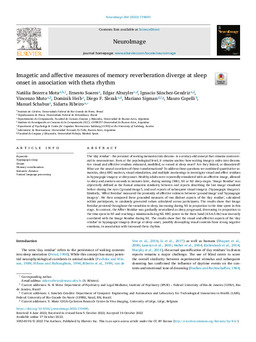| dc.rights.license | This is an open access article under the CC BY license (http://creativecommons.org/licenses/by/4.0/) | es_AR |
| dc.contributor.author | Sigman, Mariano | es_AR |
| dc.contributor.author | Bezerra Mota, Natália | es_AR |
| dc.contributor.author | Soares, Ernesto | es_AR |
| dc.contributor.author | Altszyler, Edgar | es_AR |
| dc.contributor.author | Sánchez-Gendriz, Ignacio | es_AR |
| dc.contributor.author | Muto, Vincenzo | es_AR |
| dc.contributor.author | Heib, Dominik | es_AR |
| dc.contributor.author | Slezak, Diego F. | es_AR |
| dc.contributor.author | Copelli, Mauro | es_AR |
| dc.contributor.author | Schabus, Manuel | es_AR |
| dc.contributor.author | Ribeiro, Sidarta | es_AR |
| dc.date.accessioned | 2022-11-28T21:55:03Z | |
| dc.date.available | 2022-11-28T21:55:03Z | |
| dc.date.issued | 2022 | |
| dc.identifier.citation | Mota, Soares, E., Altszyler, E., Sánchez-Gendriz, I., Muto, V., Heib, D., Slezak, D. F., Sigman, M., Copelli, M., Schabus, M., & Ribeiro, S. (2022). Imagetic and affective measures of memory reverberation diverge at sleep onset in association with theta rhythm. NeuroImage (Orlando, Fla.), 264, 119690–119690. https://doi.org/10.1016/j.neuroimage.2022.119690 | |
| dc.identifier.issn | 1053-8119 | |
| dc.identifier.uri | https://repositorio.utdt.edu/handle/20.500.13098/11460 | |
| dc.identifier.uri | https://doi.org/10.1016/j.neuroimage.2022.119690 | |
| dc.description.abstract | The ‘day residue’ - the presence of waking memories into dreams - is a century-old concept that remains controver-
sial in neuroscience. Even at the psychological level, it remains unclear how waking imagery cedes into dreams.
Are visual and affective residues enhanced, modified, or erased at sleep onset? Are they linked, or dissociated?
What are the neural correlates of these transformations? To address these questions we combined quantitative se-
mantics, sleep EEG markers, visual stimulation, and multiple awakenings to investigate visual and affect residues
in hypnagogic imagery at sleep onset. Healthy adults were repeatedly stimulated with an affective image, allowed
to sleep and awoken seconds to minutes later, during waking (WK), N1 or N2 sleep stages. ‘Image Residue’ was
objectively defined as the formal semantic similarity between oral reports describing the last image visualized
before closing the eyes (‘ground image’), and oral reports of subsequent visual imagery (‘hypnagogic imagery).
Similarly, ‘Affect Residue’ measured the proximity of affective valences between ‘ground image’ and ‘hypnagogic
imagery’. We then compared these grounded measures of two distinct aspects of the ‘day residue’, calculated
within participants, to randomly generated values calculated across participants. The results show that Image
Residue persisted throughout the transition to sleep, increasing during N1 in proportion to the time spent in this
stage. In contrast, the Affect Residue was gradually neutralized as sleep progressed, decreasing in proportion to
the time spent in N1 and reaching a minimum during N2. EEG power in the theta band (4.5-6.5 Hz) was inversely
correlated with the Image Residue during N1. The results show that the visual and affective aspects of the ‘day
residue’ in hypnagogic imagery diverge at sleep onset, possibly decoupling visual contents from strong negative
emotions, in association with increased theta rhythm. | es_AR |
| dc.description.sponsorship | Neuroimage | |
| dc.format.extent | p.1-11 | es_AR |
| dc.format.medium | application/pdf | es_AR |
| dc.language | spa | es_AR |
| dc.publisher | Elsevier Inc | es_AR |
| dc.relation.ispartof | NeuroImage, Volume 264, 1 December 2022, 119690 | |
| dc.rights | info:eu-repo/semantics/openAccess | es_AR |
| dc.subject | Hypnagogic sleep | es_AR |
| dc.subject | Dream | es_AR |
| dc.subject | Memory reverberation | es_AR |
| dc.subject | Semantic distance | es_AR |
| dc.subject | Natural language processing | es_AR |
| dc.title | Imagetic and affective measures of memory reverberation diverge at sleep onset in association with theta rhythm | es_AR |
| dc.type | info:eu-repo/semantics/article | es_AR |
| dc.type.version | info:eu-repo/semantics/publishedVersion | es_AR |

